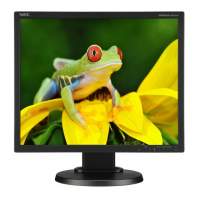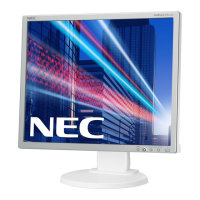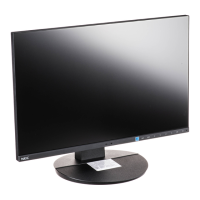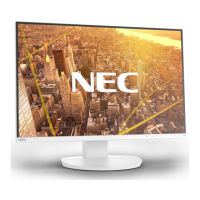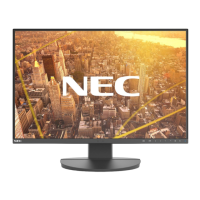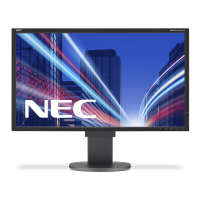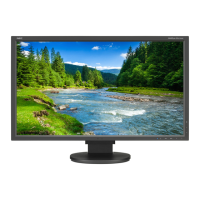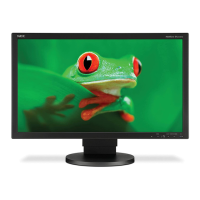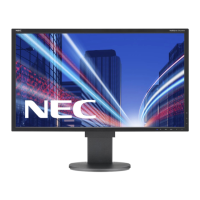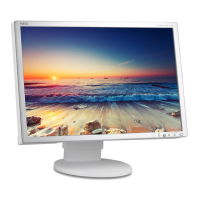Do you have a question about the NEC MultiSync EA190M and is the answer not in the manual?
| Pixel pitch | 0.294 x 0.294 mm |
|---|---|
| Vertical scan range | 56 - 75 Hz |
| Horizontal scan range | 31.5 - 81.1 kHz |
| Compatible operating systems | Windows Vista Premium |
| Operating relative humidity (H-H) | 20 - 80 % |
| Operating temperature (T-T) | 5 - 35 °C |
| Product color | Black |
| Panel mounting interface | 100 x 100 mm |
| HD type | SXGA |
| Display diagonal | 19 \ |
| Display brightness | 250 cd/m² |
| Display resolution | 1280 x 1024 pixels |
| Display technology | LCD |
| Native aspect ratio | 4:3 |
| Viewing angle, horizontal | 88 ° |
| Power consumption (standby) | 0.5 W |
| Power consumption (typical) | 23 W |
| Depth (with stand) | 213.9 mm |
|---|---|
| Width (with stand) | 408 mm |
| Height (with stand) | 496.4 mm |
| Weight (with stand) | 6600 g |
| Depth (without stand) | 65 mm |
| Height (without stand) | 338 mm |
| Weight (without stand) | 4600 g |
Critical safety warnings about fire hazards, shock, and high voltage components inside the unit.
Precautions to reduce electric shock risk, including unplugging the unit and avoiding user-serviceable parts.
Instructions for using the correct power cord based on country, voltage, and safety standards.
Declaration of product compliance with EU directives (e.g., 2006/95/EC, 2004/108/EC) and CE marking.
Statement confirming compliance with Canadian Interference-Causing Equipment Regulations for Class B digital apparatus.
Guidance on using specified cables and FCC rules to prevent radio and television interference.
Statement of compliance with FCC Rules Part 15, identifying the US responsible party and contact information.
Essential safety precautions for operating the monitor, avoiding liquids, foreign objects, and cord damage.
Steps to take if the monitor cord or plug is damaged, or if liquid is spilled or the unit is dropped.
Explanation of LCD image persistence and recommended methods to alleviate the phenomenon.
Guidelines for positioning the monitor to reduce eye, shoulder, and neck fatigue for optimal viewing.
Recommendations for adjusting brightness, contrast, and using preset controls for maximum ergonomic benefit.
Detailed instructions on how to safely clean the LCD panel and the monitor cabinet without damage.
Step-by-step guide to securely attach the monitor's base stand to the LCD panel.
Instructions for connecting the monitor to a PC or MAC using DVI digital or D-SUB analog signal cables.
Steps for tilting the monitor and connecting cables to the back, ensuring proper positioning.
Guide to turning on the monitor and computer, and how the Auto Adjust feature optimizes settings.
Instructions on how to raise, lower, tilt, and swivel the monitor screen for desired viewing angles.
Procedure for safely rotating the monitor screen from landscape to portrait orientation.
Detailed steps for disconnecting cables and removing the monitor stand for alternative mounting.
Instructions for attaching the monitor to a flexible arm using VESA standard mounting methods.
Overview of the OSD control buttons (MENU, SELECT, RESET/ECO MODE) and their primary functions.
Explanation of how to adjust Brightness, Contrast, ECO Mode, and Dynamic Visual (DV) Mode settings.
Description of the automatic adjustment feature for image position, size, and fine tuning.
Details on image controls (position, size, fine) and colour system presets (sRGB, NATIVE, RGB).
Options for volume, auto-off timer, LED brightness, DDC/CI, factory reset, language, and OSD menu positioning.
How to access information like input signal, resolution, frequency, model number, and carbon savings.
Explains the "No Signal" warning that appears when there is no video input or sync.
Describes the "Out of Range" warning for non-supported input signal timings.
Detailed specifications for the LCD module, input signals, display colours, sync range, and resolutions.
Information on power consumption, physical dimensions (landscape/portrait), and the monitor's weight.
Specifies the operating and storage temperature, humidity, and altitude ranges for the monitor.
Features like thin-frame design, crisp images, bright colours, and clear text for enhanced viewing.
Highlights the height-adjustable stand, tilt/swivel/pivot functions, and OSD controls for user comfort.
Features such as Plug and Play, Intelligent Power Manager (IPM), and Multiple Frequency Technology for ease of use and efficiency.
VESA mounting compatibility and information on the monitor's environmental impact (carbon footprint).
Solutions for common problems like no picture, power button not responding, or connectivity issues.
Steps to resolve issues such as image persistence, unstable or unfocused display, and improper picture brightness.
Troubleshooting for scenarios like no video signal, garbled text, or no sound from the monitor's speakers.
Details on the usability features verified by TCO certification, including ergonomics and image quality.
Information on the environmental advantages of TCO certified displays, such as energy efficiency and restricted materials.
Guidance on the responsible disposal and recycling of NEC products, including relevant websites.
Explanation of the monitor's advanced energy saving capabilities and power consumption levels in different modes.
Information regarding the WEEE mark for electronic waste disposal regulations within the European Union.
